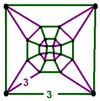Hyperbolic tetrahedral-octahedral honeycomb
| Tetrahedron-octahedron honeycomb | |
|---|---|
| Type | Compact uniform honeycomb Semiregular honeycomb |
| Schläfli symbol | {(3,4,3,3)} or {(3,3,4,3)} |
| Coxeter diagram | |
| Cells | {3,3} {3,4} r{3,3} |
| Faces | triangular {3} |
| Vertex figure |  rhombicuboctahedron |
| Coxeter group | [(4,3,3,3)] |
| Properties | Vertex-transitive, edge-transitive |
In the geometry of hyperbolic 3-space, the tetrahedron-octahedron honeycomb is a compact uniform honeycomb, constructed from octahedron and tetrahedron cells, in a rhombicuboctahedron vertex figure.
A geometric honeycomb is a space-filling of polyhedral or higher-dimensional cells, so that there are no gaps. It is an example of the more general mathematical tiling or tessellation in any number of dimensions.
Honeycombs are usually constructed in ordinary Euclidean ("flat") space, like the convex uniform honeycombs. They may also be constructed in non-Euclidean spaces, such as hyperbolic uniform honeycombs. Any finite uniform polytope can be projected to its circumsphere to form a uniform honeycomb in spherical space.
It represents a semiregular honeycomb as defined by all regular cells, although from the Wythoff construction, rectified tetrahedral r{3,3}, becomes the regular octahedron {3,4}.
Images
 Centered on octahedron |
See also
- Convex uniform honeycombs in hyperbolic space
- List of regular polytopes
- Tetrahedral-octahedral honeycomb - similar Euclidean honeycomb,





- Tetrahedral-cubic honeycomb
References
- Coxeter, Regular Polytopes, 3rd. ed., Dover Publications, 1973. ISBN 0-486-61480-8. (Tables I and II: Regular polytopes and honeycombs, pp. 294–296)
- Coxeter, The Beauty of Geometry: Twelve Essays, Dover Publications, 1999 ISBN 0-486-40919-8 (Chapter 10: Regular honeycombs in hyperbolic space, Summary tables II,III,IV,V, p212-213)
- Jeffrey R. Weeks The Shape of Space, 2nd edition ISBN 0-8247-0709-5 (Chapter 16-17: Geometries on Three-manifolds I,II)
- Norman Johnson Uniform Polytopes, Manuscript
- N.W. Johnson: The Theory of Uniform Polytopes and Honeycombs, Ph.D. Dissertation, University of Toronto, 1966
- N.W. Johnson: Geometries and Transformations, (2015) Chapter 13: Hyperbolic Coxeter groups